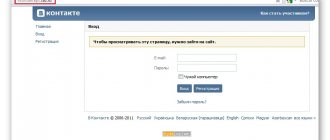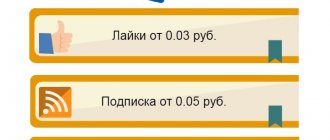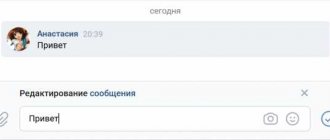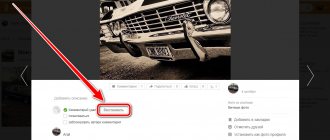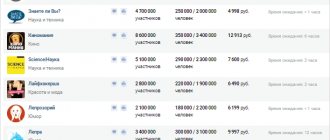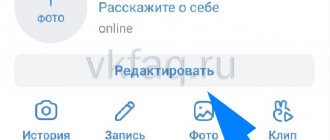Page age
Each VK page at the time of registration receives an ID, which, in essence, is its serial number. You can use it to calculate the approximate age of your account. Here are the detailed instructions:
- Go to a suspicious page and look at the address bar of your browser.
- After the “id” combination there is a combination of numbers, which is the account identification number.
- If the numeric ID has been changed to an alphabetic one, then from the user’s page you need to go to the section with his friends. The original combination will be reflected there.
Now you can determine the approximate registration date:
- If the page ID is close to 100,000,000, it means it was created around 2010.
- Pages with IDs of approximately 180,000,000 were registered in 2012.
- Accounts with an ID of about 281,000,000 are relatively young, created quite recently.
Accordingly, the page registered a couple of weeks ago deserves the closest attention. Such an account should not be trusted unconditionally. Most likely this is a fake.
Attention! Of course, the owners of such profiles come up with a variety of excuses to win over the user. For example, you can often hear: “The old page was blocked, so I created a new one.” However, access to the account is restored literally in a minute; to do this, it is enough to have access to the linked phone number. Or “I made the second page on purpose.” In this case, you can check the person’s trustworthiness by asking him to send you a message from his old account.
How to recognize a fake?
So, let's find out how to recognize a fake VKontakte page, literally, in five minutes. We will list the main points that are worth paying attention to!
Approximate date of VK profile creation
First, try to find out the ID of this page. This is a unique profile identification number that is assigned at the time of its creation.
- Go to the main page of the alleged fake and look at the address bar. The combination of numbers after the letters id is the required number.
- Some users replace the numbers in the address with a login. In this case, open the friends section and examine the address bar again. The ID will definitely be there.
So, we managed to find out the numbers, what to do next? A fake page, unless it was stolen, of course, is usually new. Created relatively recently.
In most cases, the combination is 9-digit. The closer the number is to 300,000,000, the newer the profile. For example, the page of the author of an article, which was created somewhere in 2014, has an ID of 143 120 22*. Accounts dating back to 2010 have an even smaller number. Well, those that were created quite recently are approaching three hundred million.
If, with the help of this analysis, you were able to find out that the VK page was created quite recently, most likely your suspicions are not unfounded.
Typical behavior of a fake
If you try to check a VK account for a fake directly by personally asking such a question, a true deceiver will definitely do the following:
- He'll be offended. He will write something like: “You don’t believe me, and don’t. I’m not going to prove anything...";
- He will start making excuses: “I was recently hacked, so I created a new page.” Yeah, instead of trying with all his might to return the old one, he just went and created a new one. Hard to believe;
- Share a life hack: “Listen, it’s very convenient to have two pages on VK, that’s why I recently created a new one.” And then he will give +100500 reasons why this is so cool.
In general, keep your ears open and don’t be fooled by trivial explanations.
Page activity
A simple analysis of its activity will help you distinguish a fake from a real VKontakte page. Yes, perhaps the last one will be at its best - a lot of photos, entries, posts, reposts, etc. But, you should only be interested in the date of their download. You can find it out directly in the publications themselves.
If you realize that a huge amount of varied content was uploaded in a short period of time, this is a clear sign of a fake profile. After all, in a real account, filling occurs gradually, day after day, right?
Checking photos
You can find out for sure and identify a fake on VK by looking at the photos that are uploaded to this account. Save a couple on your computer, and then run them through any free photo bank, for example, from Yandex:
- Open the Yandex search engine;
- Find the “Pictures” item under the search bar, click;
- To the right of the “Find” button (in the search bar), find the camera icon, click;
- Click the “Select file” button and specify the path from your computer to the saved photos;
- Study the results.
If the images you are looking for turn out to be popular, this is a 100% sign that the scammers took them from the Internet. They created a fake and filled it with accessible pictures. We advise you not to be lazy and check several images. By the way, pay attention to the quality and size of the images. The more often they are re-uploaded to the network, the worse they look.
This way you can find out for sure whether they are writing to you from a real page, and it is also quite possible to find a real fake person on VKontakte. That is, to find out the poor fellow whose personal data was used to create a fake.
Caught red-handed
If an online check of a VK page for a fake using the above methods did not lead to anything, it means that either the profile is real or its owner is well disguised. In the end, he could well have taken over someone else’s real page - scammers don’t even know how to do that.
How to recognize and identify such a fake VKontakte page? Try to catch a person cheating! Start communicating with him, ask questions, remember common events. Remember the famous scene from the second Terminator where the villain who pretended to be John Conor's stepmother was recognized by the wrong dog name? Proceed by analogy.
Checking friends
Do you think it is possible to identify a fake VK page from its contact list? Even if there are several hundred of them, of course yes! A large list does not mean that the profile is genuine. Remember, in most cases, fakes have exactly the same fakes as their friends. Check several pages, especially those that are more actively tagged in the account in question: they like, repost, leave comments. As a rule, fakes have no real friends.
Well, we have presented a whole range of measures demonstrating how to check a VK page for a fake. They are quite enough to expose any fraudster.
Let's say you succeeded, you managed to reliably find out that the page you were looking for is a fake, what to do next?
Authenticity of photographs
As a rule, fake accounts copy photos from original pages. Or they take them from the same “illegal” profiles. At the same time, during the process of saving and loading, images lose sharpness and become less quality. Accordingly, the more often the photo was copied, the more blurry and dull it became. You can check authenticity using Google image search:
- Select one of the photos on the page and save it to your PC.
We recommend: Unique VKontakte visitor who is it
- Upload this photo to the image search system and click the “Search” button.
- If a photo is found on the Internet very often, and the quality of the pictures posted there is noticeably higher, there is no doubt that the suspicious page on VKontakte is fake.
Attention! To make the verification results even more convincing, you need to analyze several profile photos.
Using special online services to check if a picture is fake
To check whether a photo is fake, there are special online services that allow you to analyze the authenticity of the image and find out as many details about the picture as possible.
The most famous instruments include:
| Service | Description |
| FotoForensics.com | In this service, you can submit a PNG or JPEG image by inserting its URL into a special field or uploading a photo from your computer. The tool will find areas that the user has added or added to the original image. |
| TinEye.com | This is a reverse image search service. By pasting the URL of the image into the special field, you will see a list of similar images found on the Web, starting with the largest size. |
| Findexif.com | There is no need to upload images to the server of this tool, you just need to specify the URL of the image. The service will extract EXIF data from any image in jpg format. You will receive information about the date and time the photo was added to the site, the program the user used to process the image, and other important data. |
If the photo is genuine, then the EXIF data will contain all the information, including the name of the camera model and the technical parameters of the shooting. In the case of computer processing of a photo, it will be indicated that PhotoShop or another program was used.
When using social networks, visually check the photo of the person who wants to communicate with you for a fake. If the image is too “professional” (model posing, high-quality lighting, etc.), then it may simply be taken from the Internet from the page of a famous person. Of course, a professional photo may not be fake, but it doesn’t hurt to be vigilant.
Checking the activity of a user's friends
Each VK user has a certain number of friends who from time to time like and repost content on his page. The higher the popularity of a page, the more user activity there is on it. Fake pages usually do not contain comments, there are no hearts from other people.
However, do not forget that scammers can use services to gain subscribers and friends, whose accounts must also be carefully checked.
Avatar and photos
Usually, a photo that arouses interest . If it’s a girl, then in a swimsuit, with a good figure, with emotions on her face: a smile, a laugh. If the man is either a beefy handsome guy or a “respectable entrepreneur” in a suit. Seeing a friend invitation from such a person, you will definitely go to his page, out of curiosity, see who it is.
There are few photographs in the albums:
If there are a lot of photos, then there are no friends in them, mostly these are pictures from the Internet, demotivators or beautiful photographs, and they were added in a short period of time.
There is another option to check the photo for fake VK through Google images. To do this, right-click on the photo and copy the url of the image.
To do this, go to Google images:
Click search by image:
And we get a bunch of accounts with the same photo:
Several more fake accounts were immediately identified.
How to check a photo for fake?
Today, almost all people who publish something on the Internet in one way or another cannot help but touch the photo and transform it at least a little - crop something, highlight something, apply a filter, “make” legs longer, some parts of the body more noticeable . And if sometimes you can immediately tell that the photo has been changed, for example, along with the volume of the breast, the drawing on the wall was accidentally changed, as often happens with Instagram divas, there are cases when nothing like this can be noticed at first glance. Is it really all we can do to believe?
Most often, when editing photographs, it is not the proportions that change, but the color of the picture, white balance, sharpness, and the “temperature” of the image. This is what can be the most difficult to understand.
If a person does not have a trained eye, changes in a seemingly ordinary photograph are unlikely to be noticeable, so in such cases various online services and programs come to the rescue, which, with varying degrees of detailed information, will parse the photograph into important details and report on the findings results.
The first service in the Russian Federation for checking fake news has appeared (1 photo)
Author: Tochka Zreniya
19 October 2021 14:57
Community: Online publication Tochka Vision
Tags: media internet news society media social networks technology fakes
243
1
In Russia, a service has been launched to check the authenticity of messages in the media and social networks - “Fakecheck”.
0
The essence of the project is that users of the service will be able to check for accuracy almost any messages, news, articles posted in the media, social networks and the Internet. To do this, just provide a link to the corresponding message on the Internet and order a news check. The service can also check quotes - various statements by public figures and politicians. This type of verification will probably be of the greatest interest. There are three types of checks: free - verification of socially significant information; paid verification - the resource guarantees verification of any content on the network within a certain time frame, as well as the ability to check photos; VIP verification - the service guarantees verification of a serious level, maximum analysis, short terms. In addition, the service itself will check various important messages and topics on the network, publishing an analysis of the information on its website. /* #avantisContainer0.loaded { border-top: 1px solid #BBB; border-bottom: 1px solid #BBB; padding-top: 5px; padding-bottom: 30px; } #avantisContainer0.loaded:before { content: "Advertising"; display: block; color: #BBB; } */ var fishki; if (!fishki) fishki = {}; if (!fishki.adv) fishki.adv = {}; fishki.adv.avantis = function (passback, cb, close) { fishki.onAdblockCheck( function(){ $.post('/counter/contentroll/avantis_adblock', {type: 'avantis'}); }, function () { $.post('/counter/contentroll/avantis', {type: 'avantis'}); } ); var adStarted = false; window.avantisCallback = function (eventName) { console.log("avantisEvent", eventName); switch (eventName) { case "impression": adStarted = true; $.post('/counter/contentroll/avantis_started', {type: 'avantis'}); $('#avantisContainer0').addClass('loaded'); cb('Avantis', false); break; case "adClosed": $('#avantisContainer0').removeClass('loaded'); close(true); break; case "noAd": $('#avantisContainer0').removeClass('loaded'); if (!adStarted) { $.post('/counter/contentroll/avantis_passback', {type: 'avantis'}); passback(); } break; } }; (function () { var s = document.createElement("script"); s.id="avantisJS"; s.src = "https://cdn.avantisvideo.com/avm/js/video-loader.js? id=2b71a557-f37b-4dad-827d-7f314b9a4b5e&tagId=1&subId=&callback=avantisCallback"; s.async = true; document.head.appendChild(s); }) (); } “Fakecheck is the first Russian fact-checking service that allows you to order verification of the accuracy of information on the Internet. We do not work as media, but we work with media content - both professional and social media. Fakecheck checks news and “facts” ordered by our users, and also makes special analyzes on current topics. Any user of the service can order a check - openly or anonymously, paying or free of charge, publishing it for everyone or leaving it only for themselves. Our mission is to protect society, business and every person from fakes, manipulations and fraud on the Internet,” the service says on the official website of the resource fakecheck.ru. In addition, as the service states, a set of so-called “fact checkers” will be opened in the near future. , people who will help the service identify and analyze information on the network. The company has not yet announced any selection criteria. The service was founded by two Russian journalists. Former journalist and editor of Vedomosti Dmitry Kazmin and Maxim Tovkaylo, who worked for Vedomosti, Forbes, RBC and Dozhd. It is worth noting that projects to check fakes on the Internet have recently begun to appear all over the world. This is a relatively new phenomenon, which is dictated by existing necessity, in conditions when the whole world is simply drowning in various fake news, which, for the most part, is spread on social networks. Twitter, Facebook, Google and many other companies are now engaged in the creation, development and implementation of such projects. photo: Screenshot TZ text: Alexander Tochka
Source:
Related links:
- Pulling out the infection of fakes by the roots is our task, comrades.
- Scientists have invented a new robotic arm
- In Australia, “virtual” pedophiles will have their property confiscated
- American pilots tested a flying car
- 15 crazy headlines from online media that were written by real crazy people
subscribe to the community “Network publication Tochka Vision”
Tags: media internet news society media social networks technology fakes
Did you like the post? Support Chips, click:
11 5 6
Liked
6 0
19
Partner news
Video fake
Working with such a fake is more difficult than working with pictures, since there is no easy way to search by video. If you suspect that the video you found is not true, try the following methods.
First, if you are watching a YouTube embedded window on a website, go to YouTube itself to get more information about the video (to do this, click on the video service logo in the lower right corner).
Screenshot from the Komsomolskaya Pravda website
For example, in this way we can find out that the news of the Russian “Komsomolskaya Pravda” that the people of Kiev booed Yatsenyuk and Turchynov on Victory Day in 2014 is false, since the video was uploaded to YouTube a year ago - then Yatsenyuk and Turchynov, while still in opposition, fell out of favor with supporters of the Communist Party.
Of course, there are very few such simple punctures. If there are no obvious signs of a video fake, we advise you to pay attention to the following. If the title of the video itself contains a recent date and, moreover, this video is uploaded to YouTube many times within a short period of time, there is a high probability that it is a fake. Select the video with the most views and read the comments under it - there is a high probability that among those who watched there are people who saw the original and even posted a link to it.
In addition, pay attention to the details in the video - names of objects, license plates, street signs. From them you can often determine what we are really talking about. For example, in this way we found out that the Video Azimut 46 yacht, which, according to the Russian NTV story, was allegedly given to the Odessa militia by a local businessman to protect the coast, is in fact a rental yacht and was rented by the channel’s employees to create a false story.
Another way is to describe what you see in the video with keywords and enter it into a YouTube or Google search. For example, a fragment of a video entitled Appeal to the Kiev junta from the mother of a killed military man on May 14, 2014 is being widely distributed. But when you search on YouTube using the words “appeal from the mother of a killed military man,” you can easily find the full recording of the appeal, from which it will become clear that the mother is actually appeals to Russian President Vladimir Putin with a request to stop hostilities in Ukraine.
And another way - take a screenshot of the most revealing or striking card from the video and upload it to Google image search using the method described above. There is a possibility that someone once wrote a news story with this video and used a bright screenshot as an illustration. This way you can sometimes find the original source.


